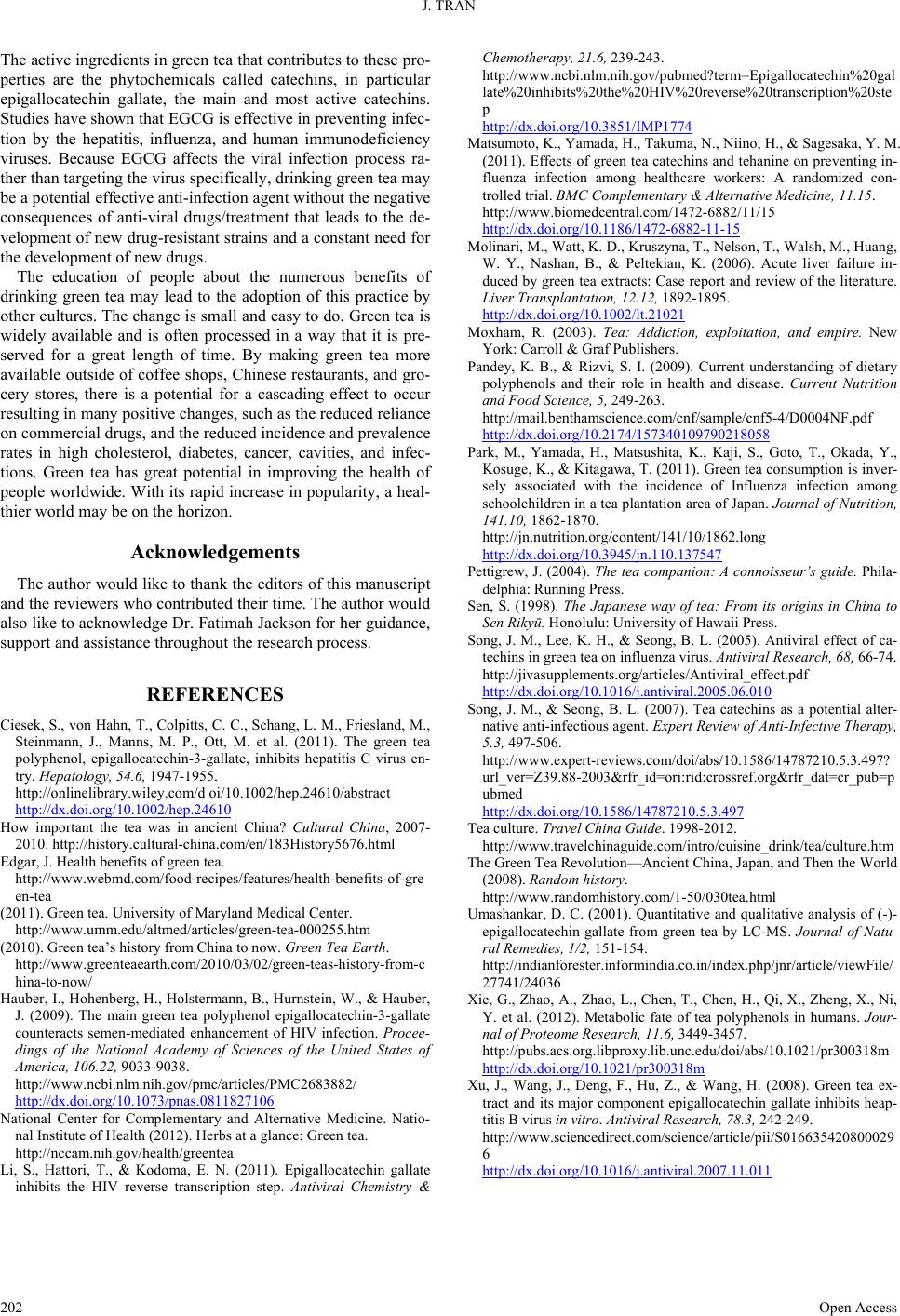
J. TRAN
Open Access
202
The active ingredients in green tea that contributes to these pro-
perties are the phytochemicals called catechins, in particular
epigallocatechin gallate, the main and most active catechins.
Studies have shown that EGCG is effective in preventing infec-
tion by the hepatitis, influenza, and human immunodeficiency
viruses. Because EGCG affects the viral infection process ra-
ther than targeting the virus specifically, drinking green tea may
be a potential effective anti-infection agent without the negative
consequences of anti-viral drugs/treatment that leads to the de-
velopment of new drug-resistant strains and a constant need for
the development of new drugs.
The education of people about the numerous benefits of
drinking green tea may lead to the adoption of this practice by
other cultures. The change is small and easy to do. Green tea is
widely available and is often processed in a way that it is pre-
served for a great length of time. By making green tea more
available outside of coffee shops, Chinese restaurants, and gro-
cery stores, there is a potential for a cascading effect to occur
resulting in many positive changes, such as the reduced reliance
on commercial drugs, and the reduced incidence and prevalence
rates in high cholesterol, diabetes, cancer, cavities, and infec-
tions. Green tea has great potential in improving the health of
people worldwide. With its rapid increase in popularity, a heal-
thier world may be on the horizon.
Acknowledgements
The author would like to thank the editors of this manuscript
and the reviewers who contributed their time. The author would
also like to acknowledge Dr. Fatimah Jackson for her guidance,
support and assistance throughout the research process.
REFERENCES
Ciesek, S., von Hahn, T., Colpitts, C. C., Schang, L. M., Friesland, M.,
Steinmann, J., Manns, M. P., Ott, M. et al. (2011). The green tea
polyphenol, epigallocatechin-3-gallate, inhibits hepatitis C virus en-
try. Hepatology, 54.6, 1947-1955.
http://onlinelibrary.wiley.com/d oi/10.1002/hep.24610/abstract
http://dx.doi.org/10.1002/hep.24610
How important the tea was in ancient China? Cultural China, 2007-
2010. http://history.cultural-china.com/en/183History5676.html
Edgar, J. Health benefits of green tea.
http://www.webmd.com/food-recipes/features/health-benefits-of-gre
en-tea
(2011). Green tea. University of Maryland Medical Center.
http://www.umm.edu/altmed/articles/green-tea-000255.htm
(2010). Green tea’s history from China to now. Green Tea Earth.
http://www.greenteaearth.com/2010/03/02/green-teas-history-from-c
hina-to-now/
Hauber, I., Hohenberg, H., Holstermann, B., Hurnstein, W., & Hauber,
J. (2009). The main green tea polyphenol epigallocatechin-3-gallate
counteracts semen-mediated enhancement of HIV infection. Procee-
dings of the National Academy of Sciences of the United States of
America, 106.22, 9033-9038.
http://www.ncbi.nlm.nih.gov/pmc/articles/PMC2683882/
http://dx.doi.org/10.1073/pnas.0811827106
National Center for Complementary and Alternative Medicine. Natio-
nal Institute of Health (2012). Herbs at a glance: Green tea.
http://nccam.nih.gov/health/greentea
Li, S., Hattori, T., & Kodoma, E. N. (2011). Epigallocatechin gallate
inhibits the HIV reverse transcription step. Antiviral Chemistry &
Chemotherapy, 21.6, 239-243.
http://www.ncbi.nlm.nih.gov/pubmed?term=Epigallocatechin%20gal
late%20inhibits%20the%20HIV%20reverse%20transcription%20ste
p
http://dx.doi.org/10.3851/IMP1774
Matsumoto, K., Yamada, H., Takuma, N., Niino, H., & Sagesaka, Y. M.
(2011). Effects of green tea catechins and tehanine on preventing in-
fluenza infection among healthcare workers: A randomized con-
trolled trial. BMC Complementary & Alternative Medicine, 11.15.
http://www.biomedcentral.com/1472-6882/11/15
http://dx.doi.org/10.1186/1472-6882-11-15
Molinari, M., Watt, K. D., Kruszyna, T., Nelson, T., Walsh, M., Huang,
W. Y., Nashan, B., & Peltekian, K. (2006). Acute liver failure in-
duced by green tea extracts: Case report and review of the literature.
Liver Transplantation, 12.12, 1892-1895.
http://dx.doi.org/10.1002/lt.21021
Moxham, R. (2003). Tea: Addiction, exploitation, and empire. New
York: Carroll & Graf Publishers.
Pandey, K. B., & Rizvi, S. I. (2009). Current understanding of dietary
polyphenols and their role in health and disease. Current Nutrition
and Food Science, 5, 249-263.
http://mail.benthamscience.com/cnf/sample/cnf5-4/D0004NF.pdf
http://dx.doi.org/10.2174/157340109790218058
Park, M., Yamada, H., Matsushita, K., Kaji, S., Goto, T., Okada, Y.,
Kosuge, K., & Kitagawa, T. (2011). Green tea consumption is inver-
sely associated with the incidence of Influenza infection among
schoolchildren in a tea plantation area of Japan. Journal of Nutrition,
141.10, 1862-1870.
http://jn.nutrition.org/content/141/10/1862.long
http://dx.doi.org/10.3945/jn.110.137547
Pettigrew, J. (2004). The tea companion: A connoisseur’s guide. Phila-
delphia: Running Press.
Sen, S. (1998). The Japanese way of tea: From its origins in China to
Sen Rikyū. Honolulu: University of Hawaii Press.
Song, J. M., Lee, K. H., & Seong, B. L. (2005). Antiviral effect of ca-
techins in green tea on influenza virus. Antiviral Research, 68, 66-74.
http://jivasupplements.org/articles/Antiviral_effect.pdf
http://dx.doi.org/10.1016/j.antiviral.2005.06.010
Song, J. M., & Seong, B. L. (2007). Tea catechins as a potential alter-
native anti-infectious agent. Expert Review of Anti-Infective Therapy,
5.3, 497-506.
http://www.expert-reviews.com/doi/abs/10.1586/14787210.5.3.497?
url_ver=Z39.88-2003&rfr_id=ori:rid:crossref.org&rfr_dat=cr_pub=p
ubmed
http://dx.doi.org/10.1586/14787210.5.3.497
Tea culture. Travel China Guide. 1998-2012.
http://www.travelchinaguide.com/intro/cuisine_drink/tea/culture.htm
The Green Tea Revolution—Ancient China, Japan, and Then the World
(2008). Random history.
http://www.randomhistory.com/1-50/030tea.html
Umashankar, D. C. (2001). Quantitative and qualitative analysis of (-)-
epigallocatechin gallate from green tea by LC-MS. Journal of Natu-
ral Remedies, 1/2, 151-154.
http://indianforester.informindia.co.in/index.php/jnr/article/viewFile/
27741/24036
Xie, G., Zhao, A., Zhao, L., Chen, T., Chen, H., Qi, X., Zheng, X., Ni,
Y. et al. (2012). Metabolic fate of tea polyphenols in humans. Jour-
nal of Proteome Research, 11.6, 3449-3457.
http://pubs.acs.org.libproxy.lib.unc.edu/doi/abs/10.1021/pr300318m
http://dx.doi.org/10.1021/pr300318m
Xu, J., Wang, J., Deng, F., Hu, Z., & Wang, H. (2008). Green tea ex-
tract and its major component epigallocatechin gallate inhibits heap-
titis B virus in vitro. Antiviral Research, 78.3, 242-249.
http://www.sciencedirect.com/science/article/pii/S016635420800029
6
http://dx.doi.org/10.1016/j.antiviral.2007.11.011